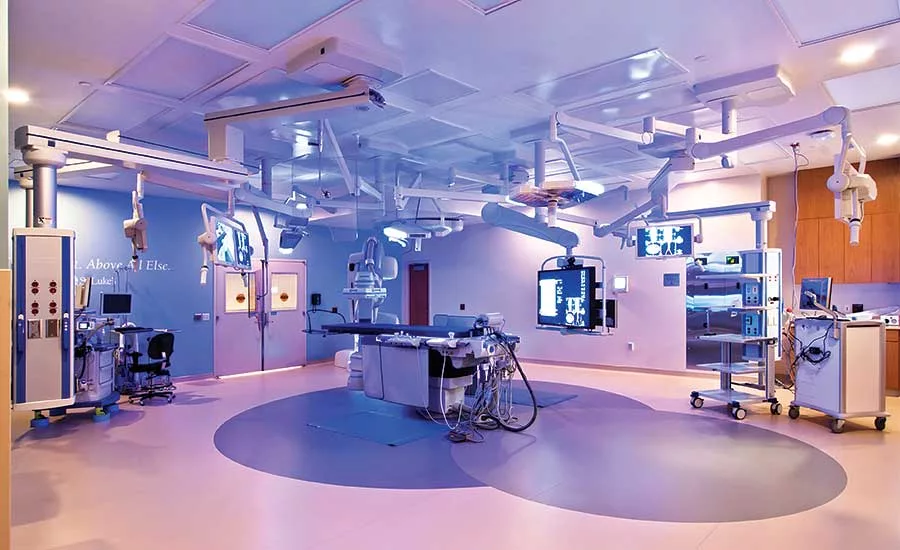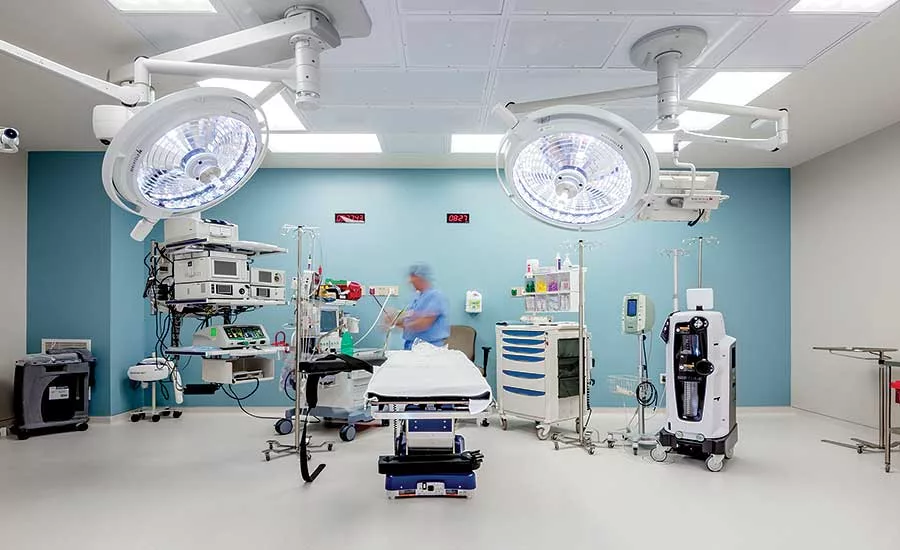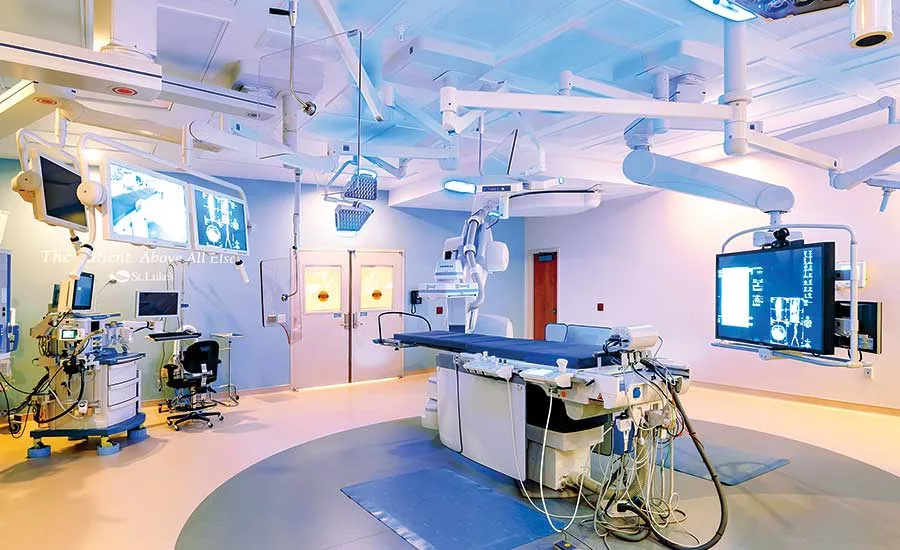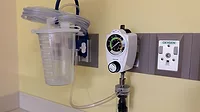Medical gas: What’s required vs. what’s desired
Anticipating your client’s needs.

It’s important to ask the right questions early when designing projects, such as the new hybrid operating room at St. Luke’s Hospital in Duluth, Minnesota. Photo credit: ERDMAN

Placement of wall outlets in patient rooms should be coordinated with the client to ensure staff and patient satisfaction, such as in this delivery room at the Family Health Pavilion at Lehigh Valley Hospital Muhlenberg Campus in Bethlehem, Pennsylvania.

In operating rooms, overhead medical gas services are not desired. Coordination of wall outlet placement is critical to preserve staff workflows and equipment movement, like in this operating room at Hendrick Surgery Center, Brownwood, Texas.

Review of site-specific medical gas boom drawings is critical to proper system design and boom installation.
Minimum requirements for medical gas services and outlets have, for a long time, been confusing to plumbing designers.
While requirements were occasionally written into state administrative codes, designers often relied on AIA Guideline recommendations when there was no clear direction. More recently, many states have adopted and enforced the FGI Guidelines. The FGI Guidelines set minimum requirements for medical gas services and outlet quantities in many different functional areas in several building types.
While these requirements provide a baseline of what to design for, clients often want services and functionality beyond the minimums, for a variety of reasons. To bridge this gap, it’s important to ask the right questions early in the project to be sure that you’re meeting your client’s expectations, not all of which might be obvious. Here, I’ll talk about things that a client might want that are beyond what the 2018 FGI Guidelines require and the reasons for them.
Operating rooms: Gas services
Operating rooms are often the most design-intensive areas of a healthcare project. The most important thing for the plumbing designer to understand is the type of procedures that will be performed in them, since FGI does not always account for what these procedures require.
FGI requires operating rooms to have oxygen, vacuum, medical air, WAGD and instrument air services. Notably missing from the list is nitrous oxide, since FGI makes no assumptions on how anesthesia will be administered. While intravenous anesthetics are becoming more common, I’ve found that many clients still want nitrous oxide as an option, so be sure to ask which they will use. Note that even if nitrous oxide is not needed, NFPA 99 still requires these rooms to be individually zoned since they are anesthetizing locations.
Another gas missing from the FGI requirements is carbon dioxide, likely because its use is specific to a small number of procedures. Carbon dioxide is often used to enlarge body cavities in endoscopy, arthroscopy and laparoscopy. Surgeons performing these procedures will often want piped services, but they will occasionally use portable cylinders instead, but be sure to ask what their preference is.
Surgeons also use a number of instrument air- or nitrogen-fired tools, and they often operate under different pressure ranges. To compensate for these different pressures, wall and ceiling outlets for these gases should be equipped with an upstream control box. Surgeons can then adjust the downstream pressure according to their specific tools and preferences. If outlets for these gases are included in an equipment boom, the control box is normally, but not always, included in the boom as well. Related to this, FGI requires an instrument air outlet in an operating room, even if the client plans to use nitrogen instead. If you run into this situation, it’s worth a discussion with the AHJ to see if they will allow a variance.
Outlet placement
The FGI Guidelines are silent on where medical gas outlets should be placed, but operating room staff will often have strong opinions on this. Wall outlets tend to be the most budget-friendly option. However, they should only be used as a last resort, since they require hoses to be run from the wall to the operating table, causing trip hazards and circulation issues for equipment and staff. If wall outlets are the only option, be sure to review locations with the client and architect to minimize their disruption to operating room workflows.
A better, but more expensive option is ceiling-mounted outlets equipped with retractable hoses, which I’ve found is a good compromise between a lean budget and good design. When using ceiling outlets, the services should be located based on discussions with the client and architect. A good place to start is to locate the anesthesia gases (oxygen, medical air and nitrous oxide) near the head of the operating table and the surgical gases (vacuum, nitrogen, instrument air and carbon dioxide) near the foot.
More coordination with your mechanical and electrical engineer will also be needed, as operating room ceilings fill up with diffusers, lights, equipment booms, electrical outlets and other elements. However, if you are using a prefabricated ceiling, the vendor will often do much of this coordination for you and provide services for you to connect to.
Medical gas booms and columns are the premium budget option, but they offer the most flexibility for operating room staff. As with other special equipment, always be sure to review the final, site-specific boom drawings for location in the room, gas service types, number of outlets and braking system type. On the last point, the braking system may be electric or powered by compressed air or nitrogen. If it is gas powered, be sure to deliver gas to the boom brakes in the desired pressure range by equipping the service branch with a regulator, if necessary. Note that brake gas does not need to be run through a zone valve since it does not go to the patient.
Recovery areas
The FGI Guidelines are very clear on gas service and outlet quantity requirements for surgery recovery areas. They distinguish between post-anesthesia care units where patients are still heavily sedated (PACU/Phase I) and more general recovery areas where sedation has mostly worn off (step-down/Phase II), and have different outlet requirements for each. However, many clients want the ability to use these room types interchangeably for flexibility. If this is the case with your project, any Phase II rooms where they want this flexibility should be given the same services and number of outlets as the Phase I rooms. Most notably, medical air is required in Phase I rooms but not Phase II, but it is not uncommon for a client to want it in both room types.
Emergency care facilities
Flexibility is also a primary medical gas design factor in emergency facilities, which can have many functionally different treatment areas. Rooms for general treatment, critical care treatment, observation, psychiatric holding, triage and trauma are the primary ones you may encounter. Similar to recovery areas, it’s not uncommon for a client to want some of these rooms to have the ability to flex as other types, and it’s important to discuss where they want this ability. Observation rooms are commonly used as overflow treatment areas during mass casualty events, so you should ask what level of service your client wants to have available in them should the need arise.
Trauma rooms can also be areas where clients want services above the FGI minimums. These rooms are ordinarily only used to stabilize patients and are not intended for surgery, and FGI therefore does not require nitrous oxide, WAGD or instrument air for them. However, there is a trend of caregivers using nitrous oxide for its calming effects on distressed patients, and clients may thus see value in having it in trauma rooms. If a client asks for nitrous oxide in these rooms, be sure to ask them what level of sedation they will use it for, as the answer will determine zoning requirements — NFPA 99 2012 and later versions require zone valves for areas where anything more than light sedation is administered. On a similar note, clients will occasionally want to use a trauma room as an operating room if the need arises, which carries the requirements discussed earlier.
Imaging areas
The FGI Guidelines identify three classes of imaging rooms, all with different medical gas service and outlet requirements. A room may be used for diagnostic imaging only (Class I), imaging in conjunction with minor procedures (Class II) or imaging in conjunction with operating room procedures (Class III). It is therefore important to ask your client what service expectations they have for a particular imaging room. Even if an imaging room is not defined as Class III, clients may still want to have nitrous oxide for sedation there, especially if the room is in an emergency care facility or near a hospital surgery area. As mentioned earlier, always ask what level of sedation will be administered there, as the answer affects zoning requirements and may have HVAC implications.
Delivery rooms
The FGI Guidelines use several terms when describing activities in standard delivery rooms (labor, delivery, recovery, antepartum and postpartum), but fortunately, medical gas service and outlet requirements are the same for all of them. Rooms used for cesarean delivery, however, require more outlets and medical air in addition to oxygen and vacuum. Clients may also want to treat a cesarean delivery room as an operating room. General anesthesia is uncommon in these procedures, but caregivers may still want this capability, which then requires nitrous oxide and WAGD services.
It should be obvious by now that the FGI Guidelines only provide a starting point for your medical gas design. Clients often want more than just the guideline minimums, and the facility type, location, caregiver preferences, and service offerings all drive their expectations.
Knowing what questions to ask during the design phase is at least as important as knowing the minimum requirements.
Looking for a reprint of this article?
From high-res PDFs to custom plaques, order your copy today!






